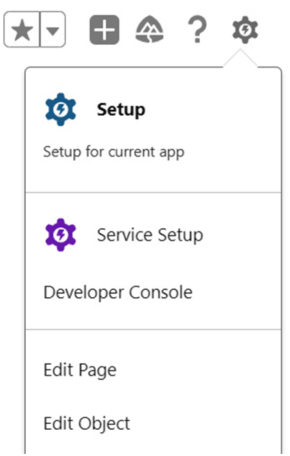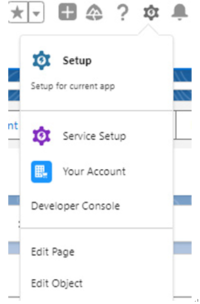The possibility of accessing the setup means that you are the master of the universe, or at least the master of your Salesforce realm. You are quite literally the “boss” of this digital “neighborhood.” To enter the Salesforce setup, all you need to do is click on the gear wheel icon located in the top-right corner of the screen:

Figure 1.9: Setup access
From this perspective, you can enter the whole treasure chamber by clicking Setup (or Service Setup if you want to mess around with Salesforce Service Cloud settings), or Edit Object if you want to go directly to one of the “treasure chambers” such as Accounts setup, Lead setup, and so on. How will you know which “chamber” you are entering? It always uses the context of the tab that you are currently in. So, if you are in the Account tab and you click Edit Object there, you will land on the Account Setup page. The same goes for other Salesforce tabs.
What can you do there? Many interesting things, such as the following:
- Add new fields
- Create field validation
- Create record action buttons and list view buttons
Record UI setup access
You might have already noticed that when you are on a specific record page and you click the gear wheel icon, you will find not only the Setup and Edit Object options but also the Edit Page option. What is this option for, you ask? Well, it’s a Salesforce mystery! Just kidding! While there are indeed many Salesforce mysteries out there, this isn’t one of them. When you click the Edit Page option, you’ll be redirected to the area where you can manage the UI or interfaces related to the object of the record you’re currently viewing. This includes the UI of objects such as Accounts, Leads, Opportunities, and more:

Figure 1.10: Object access
What can you do in this setup? Many interesting things, such as the following:
- Decide which fields are visible on the record’s UI
- Decide whether some fields should be visible, for example, only when other fields have some specific values
- Place some action buttons on the record page such as Edit, Clone, Delete, and so on
- Place some components on the record’s UI such as paths, related lists, tabs, rich text, and many, many more
- Place custom-made (coded by Salesforce programmers) components
Summary
In summary, this initial chapter has given us the basic understanding needed to grasp why Salesforce is important and how it works.
We’ve explored the pivotal role of a Salesforce Admin, gaining insights into their key responsibilities and the essential skills they need to excel. Now you know what a Salesforce Admin does, so you will now consciously follow this challenging path and you won’t be saying that no one warned you about it. So, no excuses from now, sorry!
Additionally, the section on the Salesforce certification exam has illuminated the path to becoming a certified professional. Now you know that more is sometimes less, and that you don’t need to be a Salesforce General with tons of badges and certificates on your chest to become successful, desired, or who knows, maybe even loved by the market.
Practical guidance has been offered on setting up a Salesforce account, followed by a detailed tour of the platform’s interface, enhancing readers’ ability to navigate and utilize Salesforce effectively. You are now able to create a free and endless Salesforce environment, one or a hundred of them. OK, let’s say even thousands of them. You will stop counting after the tenth.
We hope you enjoyed the first chapter of this book and are eager to explore more! Remember that Salesforce is all about development, and here, we are talking not only about app development but also, most of all, about self-development, where we believe perseverance is a key skill. So, “Stay hungry, stay foolish,” – Steve Jobs and remember, “We’ve (all) suffered losses, but we’ve not lost the war.” – Optimus Prime. This is just the beginning, and the real deal will come in the next chapters! Buckle up! Here we go!
